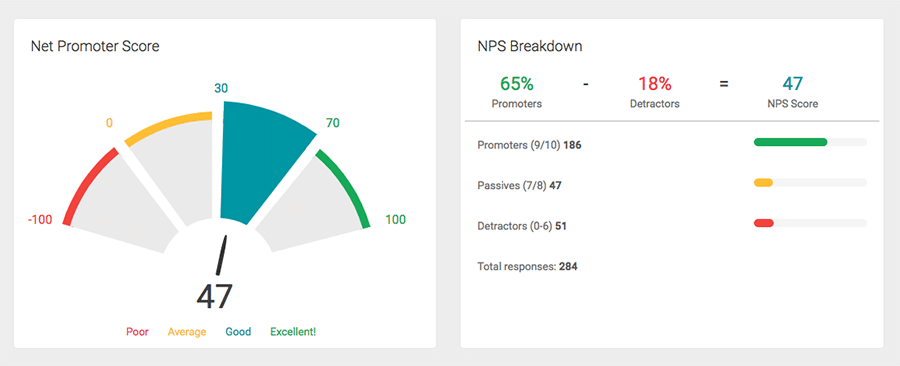
Sample NPS Report
Why You Want To Capture, Track And Use NPS For Your Business
Net Promoter Score informs you of so many important aspects of your business. You have read more than a few of these above as we explained what it is and the formula. Just a few of these are:
- An indicator of your business growth via referrals
- The outcome of your customer experience
- An indicator of customer loyalty
- Your level of customer service
- An indicator of getting good online reviews
Capturing, tracking and using NPS can be a huge difference maker. While many businesses are willing to fly blind with what their customers think, NPS can help give you an advantage to understand your customer’s loyalty and willingness to refer you. If you are a multiple location or franchise business, NPS is a fantastic way to track the performance of each location in your company. You can gleam location level insights while still measuring your NPS at a brand level. If you are a small business, you can utilize NPS to track your all too important word of mouth marketing power.
Any business will benefit from the simplicity of NPS to capture, benchmark and communicate with your staff so you can constantly improve, grow and succeed.
Wht is NPS Score?
The NPS is a way to quickly measure how satisfied your customers are with your business.
We don't all have the time and ability to do complete customer surveys, and sometimes our customers are too busy to answer lengthy forms. But what if there was an easy way to get feedback from your customers, that was simple for them too?
The basis of the Net Promoter Score is that one simple question can tell you a lot about how your customers perceive your business.
The question is: "How likely is it that you would recommend this company to a friend or colleague?"
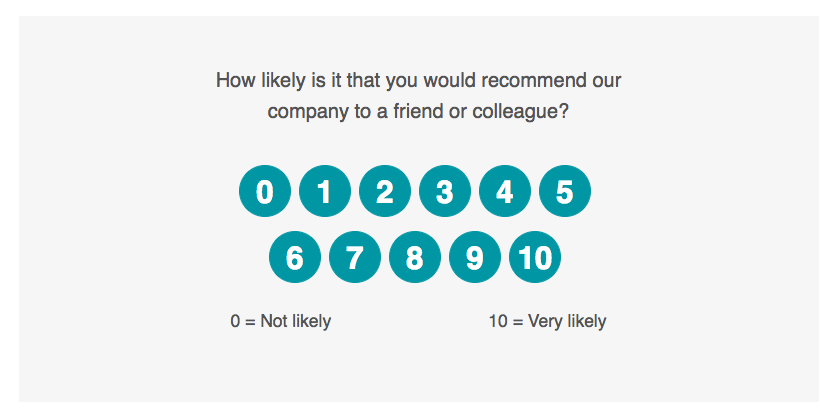
Understanding How NPS Is Calculated
Getting a grasp on NPS get’s a little tougher for many when we start to look at how Net Promoter Score is calculated. It’s because the 0-10 scale that your customers answered the NPS question with is not used directly in the form of a simple average that you would assume.
The NPS formula divides your customers answers into three categories and then subtracts just one category from another, leaving one category out entirely. See … that just sounds confusing.
But let’s simplify it by looking at each category and what they tell us about customers that fall into them.
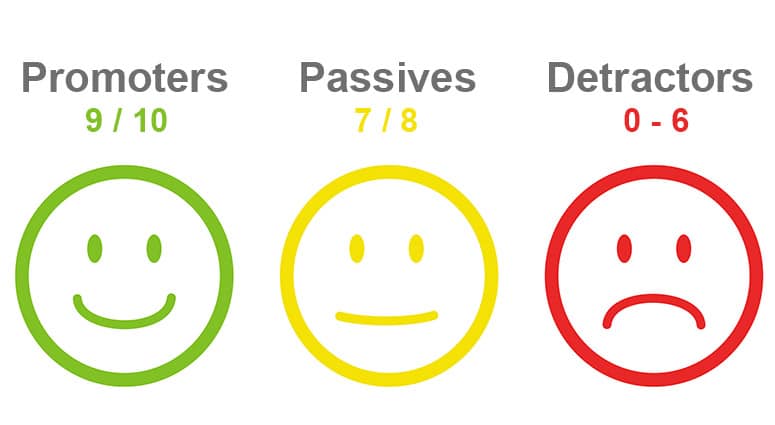
PROMOTERS
Promoters rated you a 9 or 10 on the NPS question. As the category name implies, these are your customers that will promote your business by telling others they should buy from you.
In real life, this is a customer so happy they might even tell others about your business when they haven’t even been asked about you, your service or product. They are often referred to as your brand advocates. Remember when your neighbor walked into the last neighborhood pool party and started telling everyone about the company that just painted his house? He raved how how they were affordable, meticulous and so easy to deal with. That’s a promoter, marketing for you with their opinion of their great experience.
PASSIVES
Passives rated you a 7 or an 8 on the NPS question. Your business met their expectations, but it didn’t “wow” them. They have nothing or little bad to say about you, but they aren’t confident they want to vouch for your business by telling others.In real life, you might be talking to a co-worker that tells you about the resort she just stayed at on vacation. When you asked how the place was, she said “it was fine, nothing great, nothing bad … I might try another place next time.” The business captured their money once and might see them again, but likely won’t do business with any of their friends from a referral.
Pro Tip: As you’ll learn in a bit, this category is left OUT of the NPS formula. But do not skip over this group of customers. Analyze this group and work to figure out how you can move some of them up to being a promoter to grow your business. Just as important is making sure these “passives” do not dip down into the next category we’ll look at.
You can’t please everyone, but you sure can try to develop raving fans of your business.
DETRACTORS
Detractors rated you somewhere from a 0 to 6. In your customers eyes you fell short, maybe by a few inches and maybe even by a mile if they gave you a zero or one. This category is the opposite of a promoter as instead of singing your praises, they might be telling their friends, neighbors and co-workers to avoid you at all costs.
In real life you meet up with your best friend for a beer and after small talk he asks you if he told you about his current real estate agent. He goes on a 10 minute rampage on how his Realtor never takes his calls, only follows up days later after multiple calls and emails and then messed up some paperwork causing them to waste another 2 hours on his day off. He’s not going to use or refer that Realtor to anyone and you won’t use them either. You won’t be the only one he tells this story to. Detractors are exactly that, they are taking business from you.
The NPS Formula – How It’s Calculated
Now that you understand the 0-10 scores fall into 3 categories, let’s look at how to calculate your NPS. It’s very simple. You take the % of promoters minus the % of detractors. That’s it, passives are left out. The answer is your NPS … but the formula produces a number on a scale from -100 to 100, a 200 point scale.
Here is a visual of the formula.
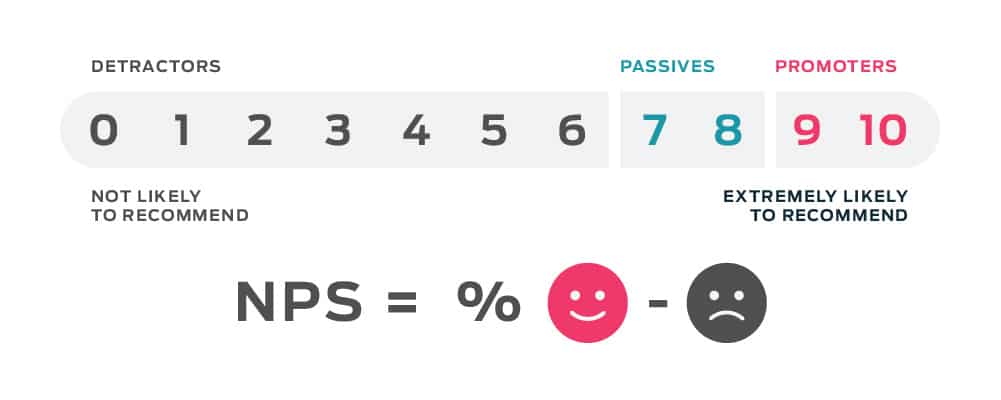
That part gets confusing as we all have been trained to think on a 100 point scale from our school days. 75% in many high school and college classes will get you a C, but in the NPS score range, a NPS score of 75 is great (like an A-). Below is an example of 100 customers answering the Net Promoter Score question and how their results factored into what the NPS score is for that business.
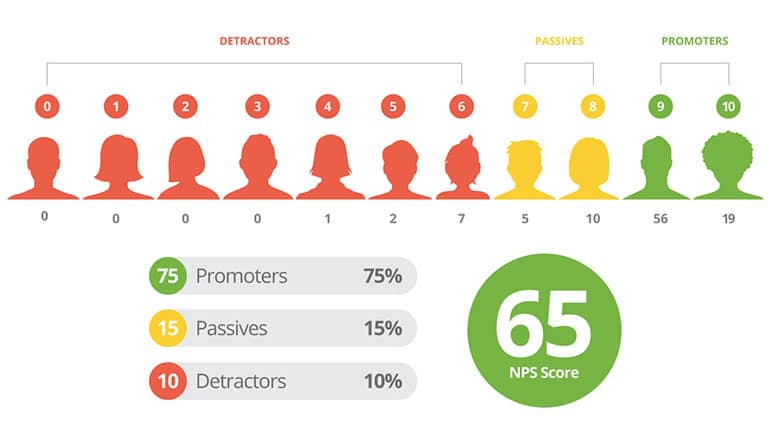
Once you calculate your NPS and get your score, here are the basic breakdowns of the score. Keep in mind all industries have varying versions of what these ranges are, but this is a simple guide for you.
- -100 to 0: Poor and needs improvement
- 1 to 30: Average
- 31 to 70: Good
- 71 to 100: Exceptional (nobody gets 100, so don’t chase that)
The simple explanation: Net Promoter Score is calculated by subtracting the percentage of your disappointed customers from the percentage of your super happy customers. The results of this formula helps you understand how likely you are to grow because you understand how likely customers are to tell others to buy from you. In one simple number.
Why and how does ReputationBuilder translate the NPS score into a 5 Star rating?
ReputationBuilder (RB) translates the NPS score into a 1-5 star rating as found on Google and Facebook etc. This is beneficial for showing testimonials and aggregated scores on your website using the Testimonials Widget. Google and other search engines will be able to index those testimonials since RB indexes them in the Schema Review Markup which is based on a 1-5 star system.
NPS Score to 1-5 Star conversion:
NPS Score 10 = 5 Stars
NPS Score 9 = 4.5 Stars
NPS Score 8 = 4 Stars
NPS Score 7 = 3.5 Stars
NPS Score 6 = 3 Stars
NPS Score 5 = 2.5 Stars
NPS Score 4 = 2 Stars
NPS Score 3 = 1.5 Stars
NPS Score 2 = 1 Star
NPS Score 1 = 0.5 Stars
NPS Score 0 = 0 Stars
NPS Score to 1-5 Star conversion for Review Widget (Full Page Layout) bar graph
NPS Score 10 = 5 Stars
NPS Score 7, 8, 9 = 4 Stars
NPS Score 5, 6, 7 = 3 Stars
NPS Score 2, 3, 4, = 2 Stars
NPS Score 0, 1 = 1 Stars
Screenshot #1: Sample Google Search Results Page
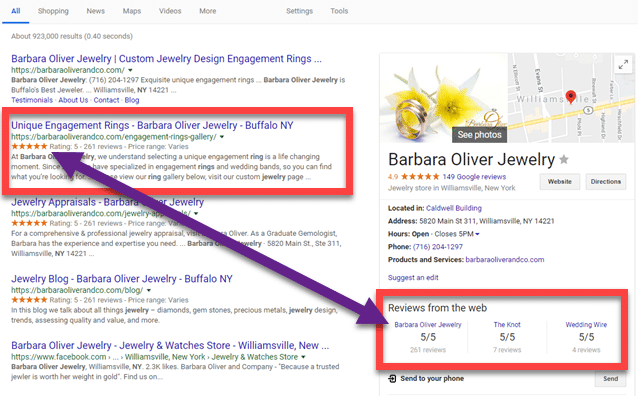
Screenshot #2: Customers review page with reviews being counted and shown as Stars.

